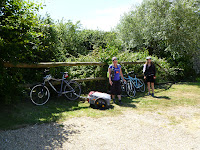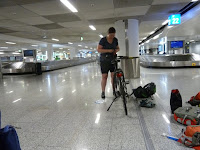Stumbling around (everywhere) is great fun, but it does have
its risks as well. One modern-day risk is
bed bugs. EEEUUUUUUUUWWWWWWW!!! Bed bugs can hitch a ride on you from
hotels, libraries, theatres… all kinds of places. They can also just make their own way into
your home (especially if you live in a multi-family structure, which Brent and I do).
With our globe-trotting lifestyle, Brent and I have
anticipated these horrifying visitors for a long time. This summer our luck ran out and the visitors
arrived. In a panic, we did a tonne of
research and took immediate action to begin the arduous task of ridding
ourselves of them.
Interestingly, before we got to the point of calling an
exterminator, we realized that we’d contained the infestation all on our own
(with good advice from a neighbor, the internet and some library books). We’ve been bite-free for several weeks, and are pretty confident we prevented a worse infestation.
But just because Brent and I got lucky and had an easy time of it AFTER infestation, that doesn’t mean YOU
will. Lots of folks have to go through a time- and effort-intensive, not to mention grossly expensive, process to rid themselves of the visitors. I’d like to share what I’ve
learned about bed bug-proofing your bed as an important aspect of
PREVENTION. Preventing an infestation
being infinitely preferable to eradicating an infestation.
There are two main things you can do with your bed to
prevent an infestation:
- Make your bed impossible for the bugs to infiltrate
- Make your bed inhospitable for an infestation in case bugs do infiltrate
Make Your Bed an Island
Bed bugs cannot fly or jump, and they have trouble walking
on slick surfaces (they CAN walk up walls).
This makes it super easy to turn your bed into an island unto itself:
- Move your bed far enough from walls and other furniture to ensure that your bedding does not touch anything (walls, other furniture, etc).
- Ensure that your bedding does not touch the floor. I use big safety pins to pin up the corners of our comforter so the corners can’t touch the floor.
- Make it impossible for the bugs to crawl up from the floor. Make sure your box spring is raised up on legs. If the legs are slick metal themselves, that may be all you need to do. With wooden legs, or other surfaces that bed bugs can climb, you can add a level of separation by sitting the legs inside of slick metal containers. You can add even another level of protection by putting oil (e.g., baby oil) inside the slick metal container so that if a bug makes it into the container, it drowns in the oil before it can journey up the bed leg. If you don’t want your bed legs to come in contact with the oil, use two nested containers: an inner one for the legs to sit in, and a larger one to contain the oil which the inner one sits in.
Make Your Bed Inhospitable
In case a bed bug is able to reach your Island Bed, make sure you make it as hard as possible for her to set up camp.
- You can buy bed bug proof mattress and box spring covers. Buy them and use them. For our box spring, instead of a commercial cover, Brent took a large sheet of plastic and encased the box spring in plastic, taped securely like a giant birthday present. We use an off-the-shelf bed bug proof mattress cover (under our regular mattress cover).
- If there’s any chance that you have a bug (or bugs) in your bed already, in addition to encasing your mattress and box spring, you should “process” your bedding by running everything through a hot dryer for an hour to kill any bugs. You can run your mattress cover and bedding through the washer and hot dryer. Run your pillows through the dryer as well.
Be safe out there, and seriously… don’t let the bed bugs
bite! Don’t even let ‘em get in bed with
you.










































